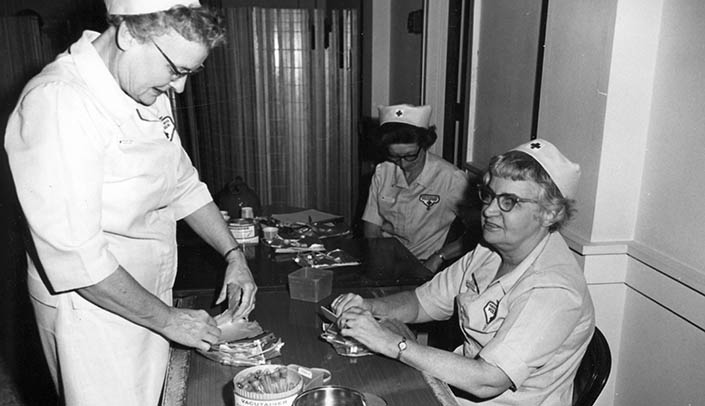Volunteers have always been an essential component of the hospital. For many years, the Gray Ladies were a positive presence on campus. Before email and the internet, they were, in the words of the American Red Cross, a “connecting link between the patient and the outside world.”
The Gray Ladies were born out of World War I. Many nurses were serving overseas at base hospitals. Recovering soldiers were returning to the United States, and nonmedical personnel were needed to fill the gap in the recovery process. In 1918, the American Red Cross founded the Hostess and Hospital Service and Recreation Corps at Walter Reed Army Hospital in Maryland.
In the years to follow, the corps worked at military and civilian hospitals, blood centers, sanitariums, clinics and convalescent homes. The corps’ name was changed to the Gray Ladies in 1947, in recognition of the gray uniforms that nonmedical Red Cross workers wore. The Gray Ladies hit a peak membership during World War II with around 50,000 nationally.
At University Hospital, the Gray Ladies worked to make the patients’ stay pleasant and comfortable. They read mail and wrote letters for patients, read books aloud or played records, played games with patients or planned surprises for patients’ special days.
Crafts brightened the pediatric wards that the Gray Ladies helped the young patients to create. They would sit with patient families in waiting areas or run errands. One of their primary, and most valuable, tasks was sitting with patients and conversing. Gray Ladies also would work at blood drives by checking in donors and providing refreshments.
Gray Ladies were retired nurses, homemakers, and others interested in giving back to their community. Volunteers were required to be between the ages of 17 and 70. “Gray Men” even joined the volunteer ranks. The volunteers completed a training class before being assigned to Gray Ladies tasks. They had to remain calm with patients and stay positive in the face of illness, loneliness and fear. They provided the care that reached beyond medical science and technology.
The American Red Cross phased out the Gray Ladies in the 1960s to create a more unified volunteer concept. The Gray Ladies are gone from Nebraska Medicine, but volunteers are still a vital component to the patient experience. They welcome patients and visitors, assist in navigation through the facilities, provide bedside tablet assistance, work in gift shops, deliver mail and provide support in various departments and clinics.
